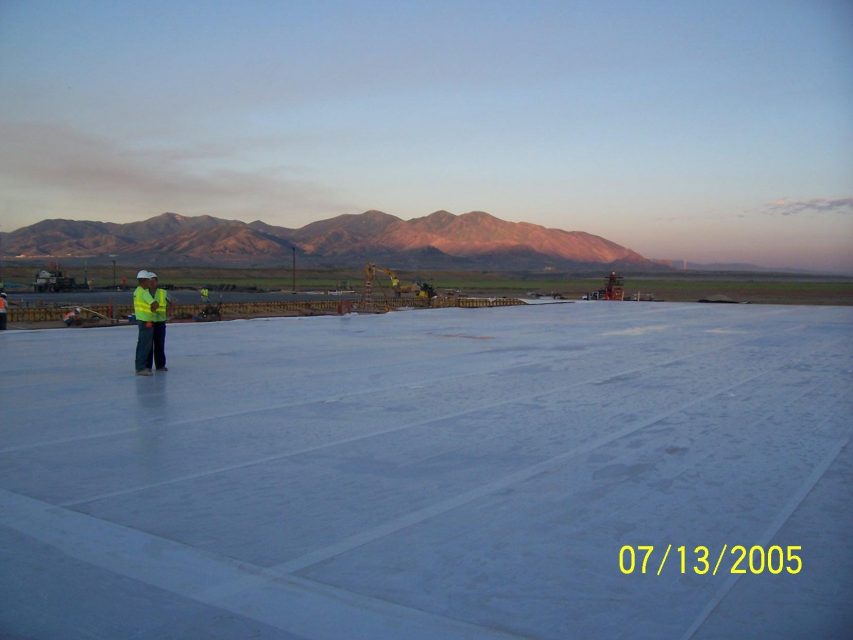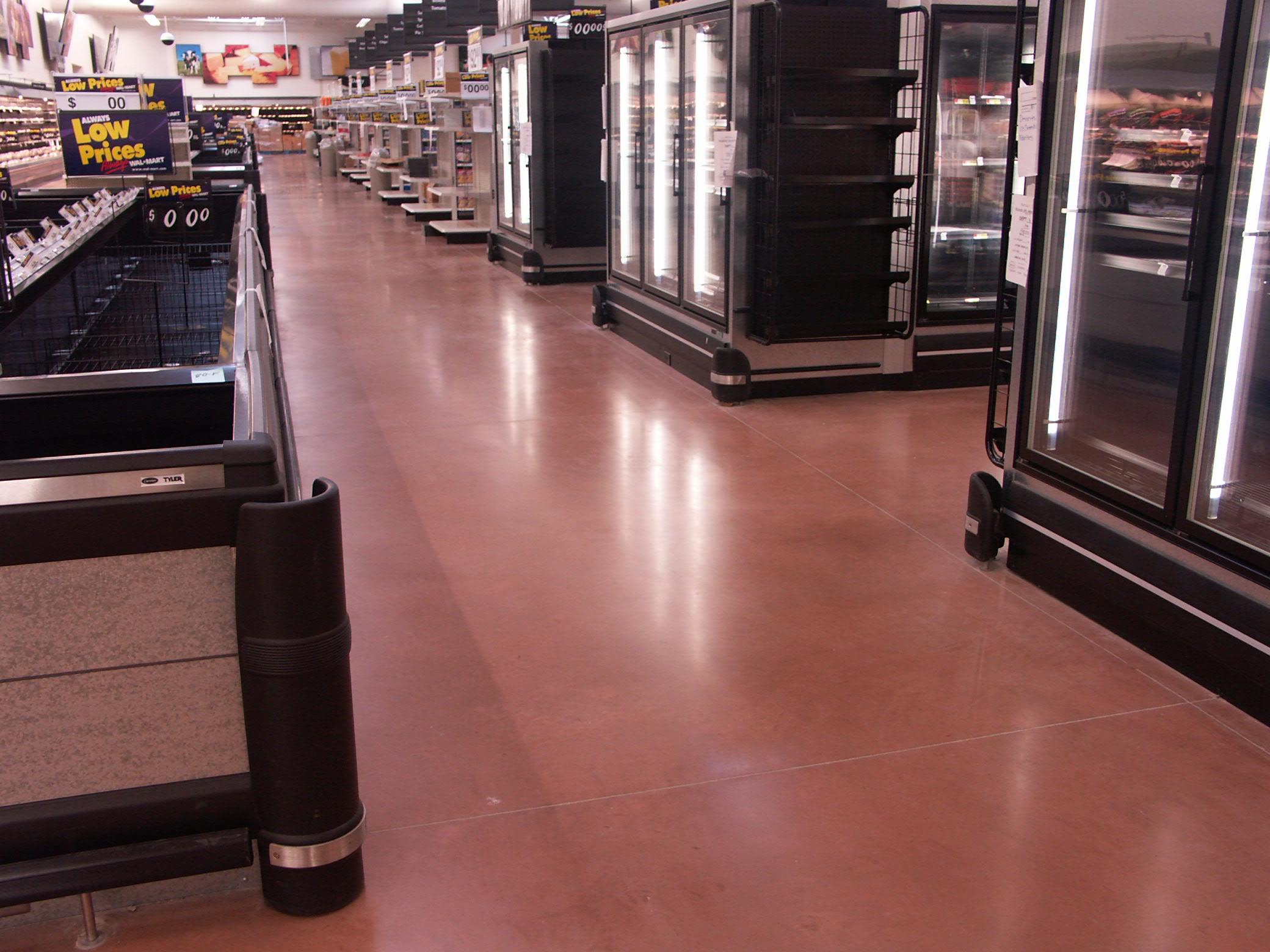There is no quick and easy way to wet-cure concrete—at least that’s what I used to believe. After 18 years as a structural engineer, I have worked on numerous slab-on-grade projects
and used traditional wet-cure methods. Most of these techniques, particularly synthetic curing blankets, were time intensive,expensive, and they sometimes left discolored areas on the slab. Because of recent industry trends, our firm has consulted on numerous integrally colored concrete slabs, where discoloration from traditional wet-curing is a major
issue. Recently however, I had an opportunity to test an innovative, wood pulp fiber fabric that readily absorbs and more evenly distributes water on both integrally colored and gray slabs.
A bit of history
To cure concrete slabs cast on the ground, contractors traditionally use ACI-recommended methods of water wet-curing. To achieve proper hydration at the concrete surface, contractors will mist or soak the concrete surface or cover the slab with soaked burlap,coated paper, plastic sheeting, or synthetic-fiber plastic-backed blankets.
Each of these water retention techniques has the same goal of hydrating the surface,thereby improving abrasion and wear resistance once cured.We have learned, however, that each of these practices has its own set of consequences.
Soaked burlap, for example, requires periodic re wetting, which may not always be done, and even then it often leaves spotty wet and dry surface areas. This can discolor concrete and leave a fabric pattern on the slab. With the trend toward decorative concrete floors, this discoloration can be a serious problem. To prevent this discoloration,burlap has to be sized and cleaned prior to use.
Plastic sheeting and coated paper both keep a slab surface moist, but these techniques are labor-intensive since the edges of the sheeting and the paper need to be overlapped and taped. If not properly taped down or weighted, winds can cause the sheeting and paper to come up in areas, leaving dry spots and uneven curing of the slab surface. Coated paper and plastic sheets can also cause discoloration from the contact and non contact areas. The non-contact areas often are significantly lighter, and in some cases, efflorescence can appear.This contrast in coloration can be an important issue since most owners want aesthetically pleasing concrete floors, for retail stores.
The most problematic hydration technique is wetting by misting, sprinkling,soaking, or flooding. Besides requiring round-the-clock observation,the wetting procedure is impractical for most construction projects and may cause problems from water runoff if not properly supervised. Excessive curing water runoff could result in the slab subbase becoming water soaked, which could weaken the base and increase curling of the slab.
 Problems with curing blankets
Problems with curing blankets
Trying to rectify the issues caused by wet curing, several manufacturers have developed improved curing blankets made of synthetic fibers bonded to impervious opaque plastic sheeting. Although these blankets are an improvement, they have some shortcomings. First, the blankets do not readily absorb water, nor do they easily lie flat after their initial use.
Although the blankets can be reused, they get dirty, are hard to store, and are difficult to clean. Unfortunately, if these blankets are not cleaned, they may create the same slab
discoloration problems as burlap. Carrying project debris from job to job does not lend itself to quality, especially on an integrally colored slab. Also, these synthetic blankets, like paper and plastic sheeting, must be overlapped, taped,and weighted to stay in place under windy conditions. And, just like with plastic sheeting, the blankets can cause discoloration and efflorescence.
A curing blanket that works
Recently, I had the opportunity to test a single-use curing blanket and to compare it with the alternatives. The product we have started to use is a wood pulp-based fiber fabric with an impervious clear plastic cap layer.
What I liked about this blanket is that it arrives at the work site clean, virtually wrinkle-free, and sealed in rolls. Once the 57-pound rolls are opened, the curing blanket is rolled out rather than laid on the wet slab. The fiber fabric readily absorbs water, and because of its wicking action, helps distribute the water to other areas on the slab to create an even, wet-cured surface.
With this new curing blanket, UltraCureNCF, there is no guessing where the dry areas are. Because of its clear plastic backing, workers can easily see areas that are dry, and wet those areas by moving water under the blanket. Another advantage of the new blanket over older synthetic products is that the UltraCure blanket edges do not have to be taped if the pieces are properly overlapped 2 to 3 inches.
This overlap proves to be a significant cost saver when compared with synthetic products, which are overlapped 8 to 12 inches. This pulp-based blanket also helps prevent discoloration because of the blanket’s absorption capability. However, I believe that despite all of these advances,the best feature of this new curing blanket is its price, which at this time is about one-half to one-third the cost of traditional synthetic curing covers.
Typical installation
Typical installation of this curing blanket is to flood the surface with water until a thin film of water, about 1⁄32 to 1⁄16 inch, stays on the surface.Remove the packaging, position on the slab with the roll edge parallel to the slab edge and unroll it, watching and correcting its position to eliminate wrinkles.Monitor the absorption, and add water if needed. If dry spots are noted, add water under the blanket with a small diameter hose or by using a roller squeegee to move the water around until the entire blanket has become translucent. The time to remain on the slab is typically referenced in the project specifications.
Most specifications require at least seven days; however this varies from a minimum of three days to 14 days for most projects; follow the project specifications.
 Comparison testing
Comparison testing
How well does this new single-use curing blanket perform compared to reused synthetic fiber blankets? To find out, we conducted a side-by-side field comparison using two slabs, both about 15,000 square feet, wetted over their entire surfaces. We used the UltraCure
blanket on one slab and previously used synthetic fiber blankets on the other.One thing we discovered was that using the noticeably dirty synthetic blankets was time-consuming and labor intensive since they had to be laid out,unfolded, and then re-positioned.
We also had problems keeping the blankets in position because of winds. In comparison, handling the pulp based blanket was much easier. Because the product comes in a roll, laborers simply pushed the roll out on the slab where it laid flat. Although
there were a few wrinkles, most were quickly eliminated with a roller.
Re positioning was minimal, and because of the nature of the product, the wind was not a problem in keeping the blankets on the slab. As the slabs cured, the wind removed about a third to half of the synthetic blankets, even though those blankets had been weighted but not taped.The pulp blanket, not weighted down or taped, remained completely in place.We attribute this to the pulp blanket’s absorbed water weight.
Removing the pulp-based cover was as easy as putting it down. Workers folded the product over itself several times and left it on the edge of the slab where it was picked up and discarded. In comparison, the synthetic cover was folded, placed on a flatbed trailer, and hauled offsite for storage and eventual reuse on another project.
The cover was not cleaned or dried before it was stored.During the curing process, the fibers on several areas of the synthetic blanket had worn off, leaving only the plastic sheeting on the slab. Also, we observed that considerably more water was retained on the pulp blanket slab surface than by the synthetic blanket.Finally and more importantly, when the two slabs dried, we clearly saw that the surface covered by the pulp-based cover was much cleaner and more uniform in appearance.
Test results
As a result of our testing, we found the pulp-based cover to have numerous advantages. First is its deep hydration capability. When properly installed,the UltraCure blanket provides
a fully saturated surface, helping the concrete to achieve more complete hydration
than other products we have used. Contractors will like the wood pulp curing product because it is cost effective in labor and material and easier to handle than reused synthetic
blankets. This technique provides a more uniformly colored concrete surface,especially important with integrally colored decorative slabs. ■
—Tim K. France is president of TKF Engineering Associates, Broken Arrow.
For additional information contact:
UltraCure NCF, McDonald
Technology Group, 866-913-8363,
www.ultracure.net, or circle 1 on the
reader service card.

Availability in Kenya through which agent?